Insurance Claim Letter Sample

Table of Contents
Insurance Claim Letter Sample: A Guide to Writing a Winning Claim
Filing an insurance claim can be stressful. A well-written claim letter significantly increases your chances of a quick and successful resolution. This guide provides a sample insurance claim letter and explains the crucial elements for maximizing your chances of approval. We'll cover everything from formatting to the inclusion of essential documentation.
Understanding the Importance of a Strong Claim Letter
Your insurance claim letter is your first formal communication with your insurance provider after an incident. A poorly written or incomplete letter can lead to delays, denials, or even the entire claim being dismissed. A strong letter, however, presents your case clearly, concisely, and persuasively, increasing the likelihood of a swift and favorable outcome.
Key Elements of a Successful Insurance Claim Letter
Before we dive into the sample, let's outline the essential components of a compelling insurance claim letter:
- Accurate Policy Information: Include your policy number, the date of the incident, and the type of insurance (e.g., auto, home, health). Double-check for accuracy; even minor errors can cause delays.
- Detailed Description of the Incident: Provide a clear and concise account of what happened. Be factual and avoid emotional language. Include dates, times, locations, and any relevant witnesses.
- List of Damages or Losses: This section requires specific details. For example, in a car accident, list all vehicle damages; for a home insurance claim, detail damaged property with estimated repair or replacement costs. Supporting documentation (photos, repair estimates) strengthens your claim considerably.
- Contact Information: Provide your current phone number, email address, and mailing address. Ensure this information is accurate and easily accessible.
- Professional Tone: Maintain a professional and respectful tone throughout the letter. Even if you're frustrated, expressing your concerns calmly and clearly is more effective.
Sample Insurance Claim Letter
[Your Name] [Your Address] [Your Phone Number] [Your Email Address]
[Date]
[Insurance Company Name] [Insurance Company Address]
Subject: Insurance Claim – Policy Number [Your Policy Number]
Dear [Insurance Adjuster Name or To Whom It May Concern],
This letter formally reports an incident that occurred on [Date of Incident] at approximately [Time of Incident] at [Location of Incident]. My policy number is [Your Policy Number].
[Clearly describe the incident. Be detailed and factual. For example: "While driving my vehicle, [Vehicle Year, Make, and Model], I was involved in a collision with another vehicle at the intersection of [Street Name] and [Street Name]. The other driver, [Other Driver's Name], ran a red light." or "A fire damaged my home located at [Your Address]. The fire appears to have started in the kitchen due to [Cause of Fire, if known]."]
As a result of this incident, the following damages or losses occurred:
- [List damages/losses with specific details. For example: "Damage to the front bumper, hood, and headlight of my vehicle," or "Damage to the kitchen, living room, and roof of my home. Estimated repair costs are approximately $[Amount]."]
I have attached [List attached documents, e.g., photographs of the damaged property, repair estimates, police report]. I request that you initiate a claim process promptly and investigate this matter thoroughly. I am available at your earliest convenience to discuss this further.
Sincerely,
[Your Signature] [Your Typed Name]
Boosting Your Claim's Success: Beyond the Letter
- Gather Evidence: Photos, videos, police reports, witness statements—all strengthen your case.
- Keep Records: Maintain copies of all correspondence and documentation related to your claim.
- Follow Up: If you haven't heard back within a reasonable timeframe, follow up with a phone call or email.
- Understand Your Policy: Review your insurance policy carefully to understand your coverage and the claims process.
This comprehensive guide and sample insurance claim letter provide a solid foundation for filing a successful claim. Remember, clarity, detail, and professional communication are key. By following these steps, you significantly improve your chances of a positive resolution. Good luck!

Thank you for visiting our website wich cover about Insurance Claim Letter Sample. We hope the information provided has been useful to you. Feel free to contact us if you have any questions or need further assistance. See you next time and dont miss to bookmark.
Featured Posts
-
Vauxhall Luton Factory Closure Likely
Nov 28, 2024
-
Vauxhall Ceo Confident On Ev Rules
Nov 28, 2024
-
Toyota Gap Insurance Coverage
Nov 28, 2024
-
Auto Insurance New Britain Ct
Nov 28, 2024
-
Liverpool Vs Real Madrid Live Stream Guide 11 27 2024
Nov 28, 2024